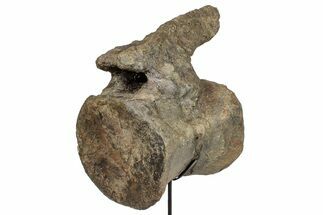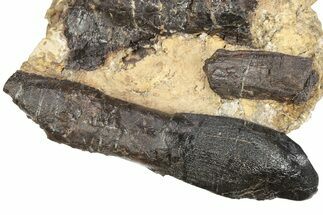This Specimen has been sold.
9.1" Polished Dinosaur Bone (Gembone) Slab - Colorado
This is a thick-cut slab of agatized, Late Jurassic-aged dinosaur bone from Colorado. It has been polished to a glossy finish on one side allowing for the beautiful internal cell structure to be easily seen. The small cells would be indicative of a non-theropod dinosaur, almost certainly one of the large sauropods like Diplodocus or Camarasaurus which are relatively common in the Morrison Formation.
The material is perfect for polishing! Comes with an acrylic display stand.
The material is perfect for polishing! Comes with an acrylic display stand.
About Dinosaur Gembone
Dinosaur gembone, also known as agatized or fossilized dinosaur bone, is a rare and highly prized material formed when the porous structure of dinosaur bone is replaced by silica-rich minerals such as agate, chalcedony, or jasper over millions of years. This fossilization process preserves the intricate internal cell patterns of the original bone, which are often visible as vibrant, web-like structures under the polished surface.
Gembone is typically found in the Morrison Formation of the American West, especially in Utah and Colorado, where Late Jurassic dinosaur remains are common. The resulting stones can display a wide range of striking colors—including reds, browns, purples, blacks, and blues—depending on the specific minerals present during fossilization.
Highly sought after by collectors, lapidary artists, and jewelers, dinosaur gembone is both a geological wonder and a tangible connection to the prehistoric past. Each piece is completely unique, with its own natural patterning and coloration shaped by ancient time and mineral-rich waters.
Dinosaur gembone, also known as agatized or fossilized dinosaur bone, is a rare and highly prized material formed when the porous structure of dinosaur bone is replaced by silica-rich minerals such as agate, chalcedony, or jasper over millions of years. This fossilization process preserves the intricate internal cell patterns of the original bone, which are often visible as vibrant, web-like structures under the polished surface.
Gembone is typically found in the Morrison Formation of the American West, especially in Utah and Colorado, where Late Jurassic dinosaur remains are common. The resulting stones can display a wide range of striking colors—including reds, browns, purples, blacks, and blues—depending on the specific minerals present during fossilization.
Highly sought after by collectors, lapidary artists, and jewelers, dinosaur gembone is both a geological wonder and a tangible connection to the prehistoric past. Each piece is completely unique, with its own natural patterning and coloration shaped by ancient time and mineral-rich waters.
About The Morrison Formation
Located in the midwestern United States, the Late Jurassic-aged Morrison Formation is an incredibly large and fossiliferous formation that dates back to about 156 to 147 million years old. Named after the small town of Morrison, Colorado, the formation was discovered in 1877, and quickly became the center of one of the biggest rivalries in historical paleontology.
19th century paleontologists Othniel Charles Marsh and Edward Drinker Cope spent 15 years making outstanding strides in the discovery of fossils all throughout the American Midwest, but also resorted to unsavory methods in attempts to discredit or ruin the other's work and reputation, including destruction of specimens.
The total area of the formation is roughly 600,000 square miles, but much of that is inaccessible, deeply buried under prairie land and eroded during the formation of the Rocky Mountains. Even so, many outcroppings across the Front Range and upper Midwest allow paleontologists access to a wealth of information from Late Jurassic North America.
Dinosaurs from the region include large allosaurid dinosaurs, such as the eponymous Allosaurus and its larger relative Saurophaganax. Both exceeded 30 feet in length, making them some of the largest carnivores of their time. They competed with the similarly large megalosaurid Torvosaurus, and the somewhat smaller horned ceratosaurid, Ceratosaurus. On the smaller end of the theropod family tree was the raptor-like Ornitholestes.
For herbivores, Stegosaurus guarded their herds with huge, intimidating backplates and formidable tail spikes. Small, early ankylosaurs like Gargoyleosaurus would have fed on the forested understory, smaller in size than the 30+ foot giant Stegosaurids.
However, the Morrison Formation's main attraction were the giant sauropod dinosaurs, some of the most colossal of dinosaurs and largest land animals of all time. Diplodocus, Camarasaurus, Apatosaurus, Brontosaurus, Brachiosaurus, Barosaurus, and Supersaurus all count themselves among these long-necked titans. None of these herbivores would have been less than 50 feet in length at adult size: the largest of their number would have exceeded 100-115 feet in length, and over 40 tons. For so many sauropods to have lived in roughly the same place and time, they all likely developed different feeding and living strategies to minimize competition. Their massive sizes and herds would have defended them well from any of the numerous predators of the Morrison.
Located in the midwestern United States, the Late Jurassic-aged Morrison Formation is an incredibly large and fossiliferous formation that dates back to about 156 to 147 million years old. Named after the small town of Morrison, Colorado, the formation was discovered in 1877, and quickly became the center of one of the biggest rivalries in historical paleontology.
19th century paleontologists Othniel Charles Marsh and Edward Drinker Cope spent 15 years making outstanding strides in the discovery of fossils all throughout the American Midwest, but also resorted to unsavory methods in attempts to discredit or ruin the other's work and reputation, including destruction of specimens.
The total area of the formation is roughly 600,000 square miles, but much of that is inaccessible, deeply buried under prairie land and eroded during the formation of the Rocky Mountains. Even so, many outcroppings across the Front Range and upper Midwest allow paleontologists access to a wealth of information from Late Jurassic North America.
Dinosaurs from the region include large allosaurid dinosaurs, such as the eponymous Allosaurus and its larger relative Saurophaganax. Both exceeded 30 feet in length, making them some of the largest carnivores of their time. They competed with the similarly large megalosaurid Torvosaurus, and the somewhat smaller horned ceratosaurid, Ceratosaurus. On the smaller end of the theropod family tree was the raptor-like Ornitholestes.
For herbivores, Stegosaurus guarded their herds with huge, intimidating backplates and formidable tail spikes. Small, early ankylosaurs like Gargoyleosaurus would have fed on the forested understory, smaller in size than the 30+ foot giant Stegosaurids.
However, the Morrison Formation's main attraction were the giant sauropod dinosaurs, some of the most colossal of dinosaurs and largest land animals of all time. Diplodocus, Camarasaurus, Apatosaurus, Brontosaurus, Brachiosaurus, Barosaurus, and Supersaurus all count themselves among these long-necked titans. None of these herbivores would have been less than 50 feet in length at adult size: the largest of their number would have exceeded 100-115 feet in length, and over 40 tons. For so many sauropods to have lived in roughly the same place and time, they all likely developed different feeding and living strategies to minimize competition. Their massive sizes and herds would have defended them well from any of the numerous predators of the Morrison.
SPECIES
Unidentified Sauropod
LOCATION
Colorado
FORMATION
Morrison Formation
SIZE
9.1 x 3.8", 1.5" thick
CATEGORY
SUB CATEGORY
ITEM
#324198
We guarantee the authenticity of all of our specimens.
 Reviews
Reviews











